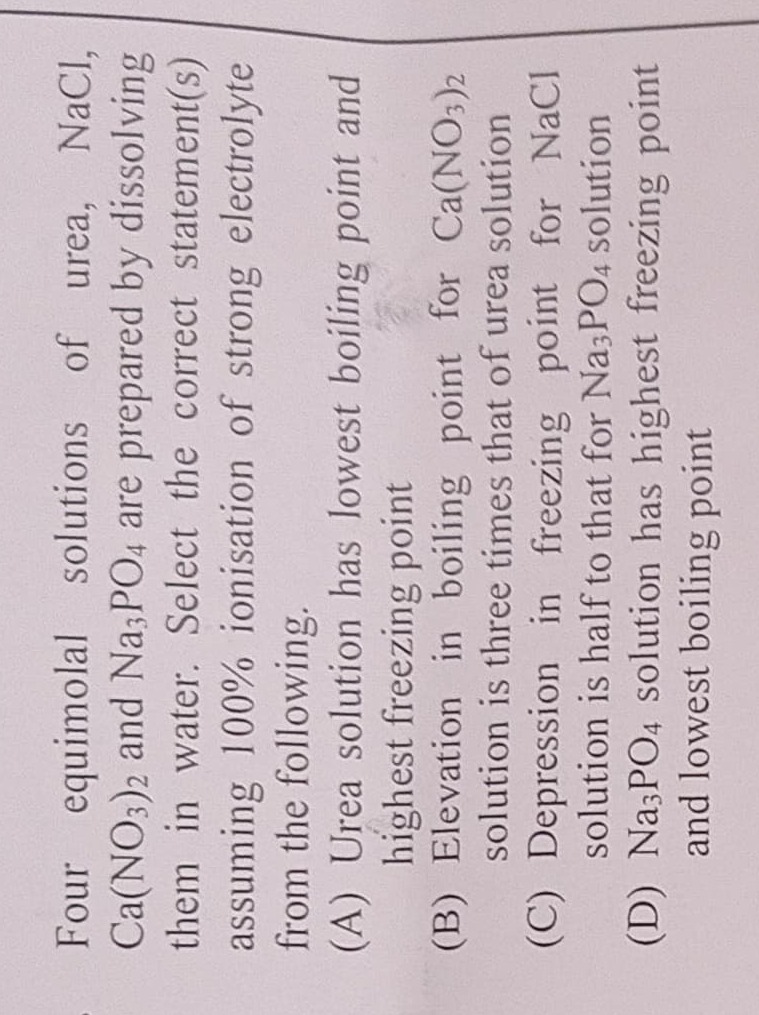Question
Question: Four equimolal solutions of urea, NaCl, Ca(NO$_{3}$)$_{2}$ and Na$_{3}$PO$_{4}$ are prepared by diss...
Four equimolal solutions of urea, NaCl, Ca(NO3)2 and Na3PO4 are prepared by dissolving them in water. Select the correct statement(s) assuming 100% ionisation of strong electrolyte from the following.

Urea solution has lowest boiling point and highest freezing point
Elevation in boiling point for Ca(NO3)2 solution is three times that of urea solution
Depression in freezing point for NaCl solution is half to that for Na3PO4 solution
Na3PO4 solution has highest freezing point and lowest boiling point
A, B, C
Solution
To determine the correct statements, we need to analyze the colligative properties of the given equimolal solutions. Colligative properties depend on the number of solute particles in the solution, which for electrolytes is represented by the van't Hoff factor (i).
The formulas for elevation in boiling point (ΔTb) and depression in freezing point (ΔTf) are:
ΔTb=i⋅Kb⋅m ΔTf=i⋅Kf⋅mWhere Kb is the molal elevation constant, Kf is the molal depression constant, and m is the molality of the solution. Since all solutions are equimolal, m is the same for all. Kb and Kf are constants for the solvent (water).
The boiling point of the solution (Tb) is given by Tb=Tb0+ΔTb, where Tb0 is the boiling point of the pure solvent. The freezing point of the solution (Tf) is given by Tf=Tf0−ΔTf, where Tf0 is the freezing point of the pure solvent.
First, let's determine the van't Hoff factor (i) for each solute, assuming 100% ionization for strong electrolytes:
-
Urea (CO(NH2)2): Urea is a non-electrolyte and does not dissociate. i=1
-
NaCl: NaCl is a strong electrolyte and dissociates into two ions (Na+ and Cl−). NaCl(aq) → Na+(aq) + Cl−(aq) i=2
-
Ca(NO3)2: Ca(NO3)2 is a strong electrolyte and dissociates into three ions (Ca2+ and 2NO3−). Ca(NO3)2(aq) → Ca2+(aq) + 2NO3−(aq) i=3
-
Na3PO4: Na3PO4 is a strong electrolyte and dissociates into four ions (3Na+ and PO43−). Na3PO4(aq) → 3Na+(aq) + PO43−(aq) i=4
Now, let's compare the colligative properties based on the 'i' values: Since ΔTb∝i and ΔTf∝i:
- A higher 'i' value leads to a greater elevation in boiling point (ΔTb) and thus a higher boiling point (Tb).
- A higher 'i' value leads to a greater depression in freezing point (ΔTf) and thus a lower freezing point (Tf).
The order of 'i' values is: Urea (1) < NaCl (2) < Ca(NO3)2 (3) < Na3PO4 (4)
Therefore:
-
The order of ΔTb and Tb (from lowest to highest) is: Urea < NaCl < Ca(NO3)2 < Na3PO4 (Urea solution has the lowest boiling point; Na3PO4 solution has the highest boiling point).
-
The order of ΔTf (from lowest to highest) is: Urea < NaCl < Ca(NO3)2 < Na3PO4
-
The order of Tf (from highest to lowest) is: Urea > NaCl > Ca(NO3)2 > Na3PO4 (Urea solution has the highest freezing point; Na3PO4 solution has the lowest freezing point).
Now, let's evaluate each statement:
(A) Urea solution has lowest boiling point and highest freezing point
- Urea has the lowest 'i' value (i=1). This means it has the lowest ΔTb and thus the lowest boiling point.
- It also has the lowest ΔTf and thus the highest freezing point.
- This statement is Correct.
(B) Elevation in boiling point for Ca(NO3)2 solution is three times that of urea solution
- ΔTb (Ca(NO3)2) = iCa(NO3)2⋅Kb⋅m=3⋅Kb⋅m
- ΔTb (Urea) = iUrea⋅Kb⋅m=1⋅Kb⋅m
- Therefore, ΔTb (Ca(NO3)2) = 3 × ΔTb (Urea).
- This statement is Correct.
(C) Depression in freezing point for NaCl solution is half to that for Na3PO4 solution
- ΔTf (NaCl) = iNaCl⋅Kf⋅m=2⋅Kf⋅m
- ΔTf (Na3PO4) = iNa3PO4⋅Kf⋅m=4⋅Kf⋅m
- Therefore, ΔTf (NaCl) = (2/4)⋅ΔTf (Na3PO4) = 0.5⋅ΔTf (Na3PO4).
- This statement is Correct.
(D) Na3PO4 solution has highest freezing point and lowest boiling point
- Na3PO4 has the highest 'i' value (i=4). This means it has the highest ΔTb and thus the highest boiling point.
- It also has the highest ΔTf and thus the lowest freezing point.
- The statement claims highest freezing point and lowest boiling point, which contradicts our findings.
- This statement is Incorrect.
Based on the analysis, statements (A), (B), and (C) are correct.
